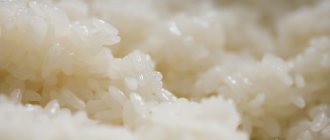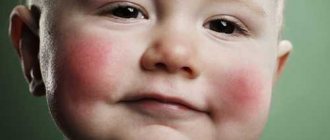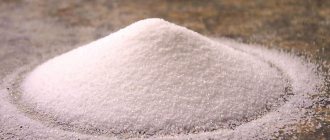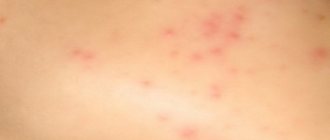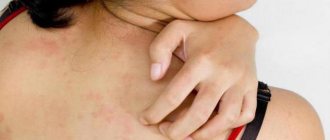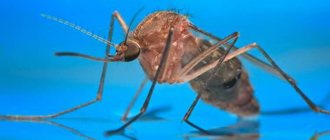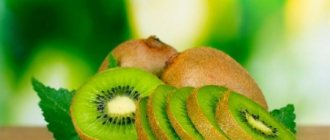How to distinguish allergies from ARVI?
Diagram of the differences between allergies and colds
Runny nose, watery eyes, red eyes and constant sneezing - these unpleasant symptoms can complicate the life of both a child and an adult. In order to eliminate these symptoms, you need to figure out whether you have an allergy or an acute respiratory viral infection (ARVI).
Let's understand the terminology and causes of seasonal allergies. Allergic rhinitis is a disease in which allergic inflammation occurs in the nasal cavity due to contact with an allergen. The most common allergens include: dust, house dust mites, animal hair, plant pollen, mold spores. Food products can also cause: runny nose, nasal congestion, sneezing. Food allergies are often accompanied by rash (hives), swelling, anaphylaxis (choking).
ARVI is a disease that includes a number of diseases of the upper respiratory tract caused by a viral pathogen. Seasonal epidemics occur in the autumn-winter period. The main causative agents of ARVI are viruses that enter the body upon contact with a carrier of the virus. Allergies and ARVI have several similar symptoms, which is why these two diseases are often confused. Common symptoms between allergies and ARVI:
- sneezing, itchy nose;
- sore throat;
- severe runny nose;
- nasal congestion;
- lacrimation.
In order to determine whether you have an allergy or an acute respiratory viral infection, you should pay attention to the symptoms that distinguish these two diseases. The photo shows a seasonal allergic reaction on the face of a child:
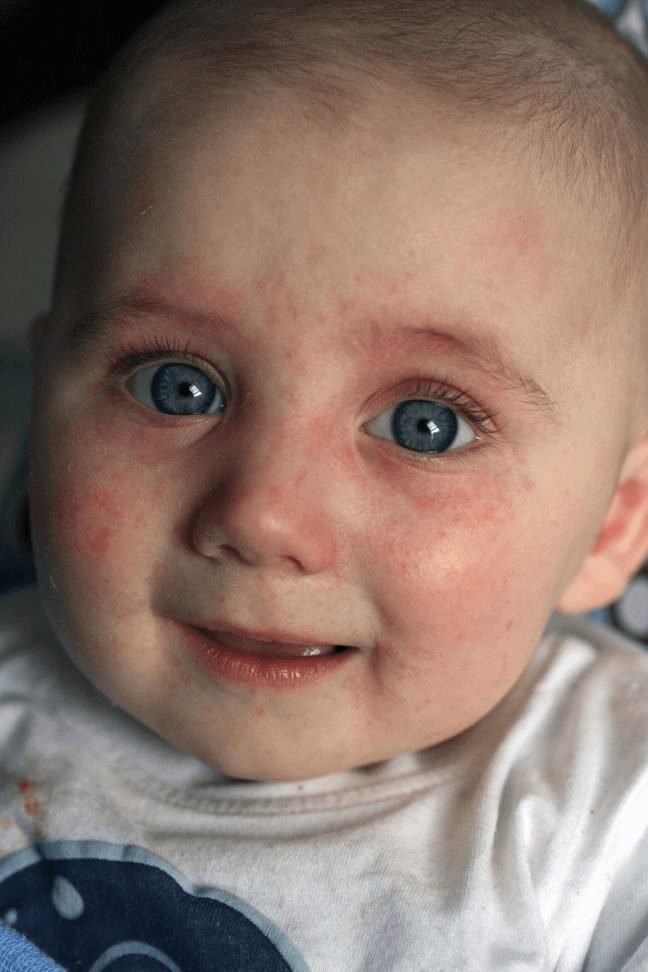
Photo: Seasonal allergic reaction on a child’s face
With ARVI, symptoms may be observed that are absent or mild in allergic conditions. Among the distinctive symptoms of ARVI you can find:
- headache;
- signs of intoxication (weakness, “broken” general condition, drowsiness);
- pain in joints and muscles;
- temperature rise 37.2/37.5;
- a sore throat.
Seasonal allergies may also cause a slight rise in temperature. Allergies can also cause headaches in extremely rare cases. However, if any of these symptoms bother you, there is a high probability that you have “caught” the virus, but only a doctor can make an accurate diagnosis.
Why do seasonal allergies occur?
Young mothers are often interested in why seasonal allergies appear? Leading allergists argue that allergies occur when the immune system fails, which perceives certain substances as a danger to the body. Sometimes seasonal allergies are influenced by psychosomatics. That is, a person may not be sensitive to certain foods or flowers, but feel allergy symptoms. In order to avoid exacerbation, it is necessary to prepare for this in advance.
Differences between seasonal allergy symptoms and coronavirus infection
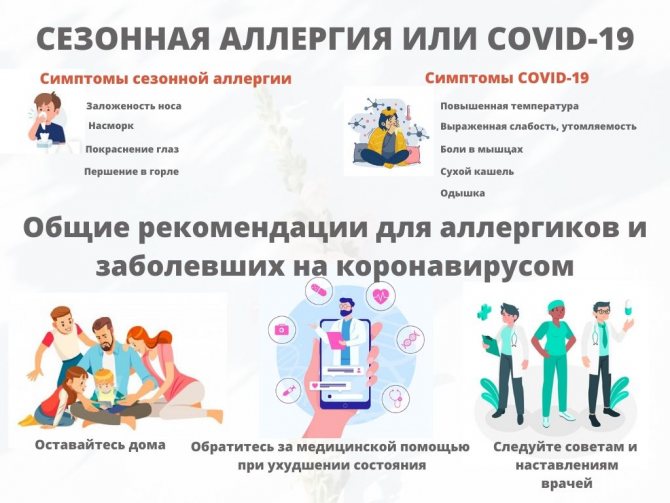
An allergic reaction is not an increased risk of infection. That is, it is not transmitted by airborne droplets like COVID-19. However, coronavirus infection can provoke an allergy to antiseptics in people who use them excessively. In turn, allergies can cause a number of uncomfortable side effects, such as asthma and chronic obstructive pulmonary disease, which also negatively affect the respiratory system. Let's look at how you can distinguish seasonal allergies from coronavirus. With seasonal allergies, the following symptoms are not observed:
- elevated temperature;
- severe fatigue, lethargy;
- muscle pain;
- cough (except for patients with bronchial asthma);
- shortness of breath (except for patients with bronchial asthma).
Let's not downplay the danger
Seasonal allergies are dangerous primarily due to cross-reactions. This means that in addition to sensitivity to pollen, the allergic person’s body cannot tolerate provocateurs that have similar characteristics, such as those contained, for example, in animal fur.
If allergic conjunctivitis, sneezing and other signs appear, you should eat certain fruits and berries, greens, nuts, carrots, and celery with great caution. If you are allergic to cereal pollen, you need to stop eating white bread and all bakery sweets, store-bought sausage, and kvass.
Summer allergies also threaten anaphylactic shock and angioedema if you take the treatment and advice of an allergist-immunologist lightly.
Main allergens of seasonal allergies
The most common signs of seasonal allergies occur in the spring. However, allergies can begin earlier, in February, and last until early summer. The flowering of trees continues with the flowering of grass until late spring, then summer comes, rich in various flowerings. In tropical climates, plants can be pollinated for most of the year. Mild winter temperatures can cause plants to pollinate early. A rainy spring can also encourage rapid plant growth and mold growth, causing allergy symptoms well into the fall.

Table of main seasonal allergens
Main allergens in winter
It would seem that what can trigger seasonal allergies in winter? However, not everything is so simple; in winter, children are allergic to cold
.
This allergy appears on the skin in the form of urticaria and dermatitis. According to dermatologists, cold urticaria appears in the first 15-20 minutes after returning from the cold. Most often, cold dermatitis appears on the face, hands and ears. In winter, fur allergies
. Fur coats and hats made from natural fur are the most common causes of allergies. Replace fur clothing with padding polyester clothing; it is warm enough and does not cause allergies.
Since we spend a lot of time at home in winter, we may experience household allergies. It usually occurs as a reaction to dust or cleaning products. To reduce allergens in your home, you should do frequent wet cleaning and walk in the fresh air.
Main allergens in spring
As we have already written, spring is the most common allergy season. This is due to pollen
. The main sources of pollen in spring are: ash, willow, alder, aspen, beech, elderberry, sycamore, poplar, maple, mulberry, oak and pine.
Among the herbs and shrubs
The most common allergens are: Bermuda grass, fescue, Johnson grass, thinlegs, perennial rye, white bentgrass, spiked grass and timothy grass.
To avoid acute allergy reactions, try not to walk in windy weather (as the wind disperses pollen well).
Main allergens in summer
Summer is full of flowering plants, fruits and vegetables. The main summer allergens are:
- sun solar dermatitis )
. Solar allergies occur due to the interaction of sunlight with bleach, alcohol-containing products (antiseptics), creams, medications, and pollen. - plant pollen
. Each month is rich in its own blooms, for example, May-June is filled with flowering of deciduous and coniferous trees, June-July - with the flowering of cereal plants, August - with the flowering of sunflowers, buckwheat, nettles, plantains and other weeds. - fruits and vegetables
. Brightly colored fruits such as strawberries, raspberries, tomatoes, and red apples can cause food allergies or cross-allergies (an immune response to allergenic molecules in foods).
Main allergens in autumn
In the fall, the second stage of acute allergy symptoms occurs. The main allergen remains the same plant pollen. The most common fall allergen is ragweed
(blooms and releases pollen from August to November).
Other plants that cause autumn allergies include:
- Aeonimus (burning bush);
- cocklebur;
- Pigweed;
- Sagebrush;
- Tumbleweed;
- Thistle.
Another common fall allergen is mold
, whose spores are carried over a distance of 100 kilometers. The most common places for mold to grow are basements, closets, bathrooms, and fallen leaves outside.
Dust mites
. They arise due to high humidity, live in apartments and if they enter the respiratory system they can cause an allergic runny nose.
Periods of exacerbation of seasonal allergies
It is quite easy to understand when seasonal allergies occur during the flowering season - during the season of pollen distribution. They are observed at certain times of the year, especially in spring, summer or autumn, during the season of distribution of the main allergens. Symptoms are primarily observed in the nasal mucosa, causing allergic rhinitis, swelling of the eyelids and whites of the eyes (conjunctivitis). Let's take a closer look at what can cause seasonal allergies. Common triggers for hay fever vary from season to season.
in spring
Trees are the cause of most spring seasonal allergies. The most common allergen is birch pollen. Other tree allergens include cedar, alder, horse chestnut, willow and poplar. Common herbal allergens include wormwood, quinoa, dandelion, hemp, nettle and buttercup.
In summer
Hay fever gets its name from the hay season, which traditionally occurs during the summer months.
But the real culprits of summer seasonal allergies are grasses such as rye, wheat, fescue, bluegrass, wheatgrass, bromegrass, buckwheat, ryegrass and timothy, as well as some weeds. According to medical statistics, herbs are the most common trigger for people with hay fever. In Autumn
Autumn is ragweed season. It is an invasive plant that is difficult to control. Its pollen is a very common allergen, and ragweed allergy symptoms can be particularly severe. Other fall allergens include: nettle, wormwood and sorrel.
in winter
By winter, most outdoor allergens are dormant. As a result, cold weather brings relief to many people with hay fever. But it also means more people are spending time indoors. If you're prone to seasonal allergies, you may also react to indoor allergens such as mold, pet dander, dust mites and cockroaches.
It is impossible to determine exactly when seasonal allergies end or when seasonal allergies begin. However, it is possible to stop its acute symptoms. Let's take a closer look at what symptoms characterize seasonal allergies.
Provocateurs
First you need to determine what you might be allergic to in a certain month in the summer. This is done through an examination in a hospital. The table below shows the main provocateurs.
| Month | Allergens |
| June | Coniferous shrubs and trees, linden trees, begin to bloom. Among the herbaceous plants: nettle, wheatgrass, brome, timothy, fescue. |
| July | The most dangerous plants for allergy sufferers are: buckwheat, rye, ash, wormwood. |
| August | At the end of summer, the so-called complex plant species bloom: plantain, sorrel. |

We must not forget that in the summer the attack of various insects begins, and many people develop a negative reaction to their bites.
Symptoms of seasonal allergies and why seasonal allergies are dangerous
If you sneeze and cough at certain times of the year, you may have seasonal allergies. However, occasional allergies are not something you just have to live with. An allergist can pinpoint the cause and help you achieve relief.
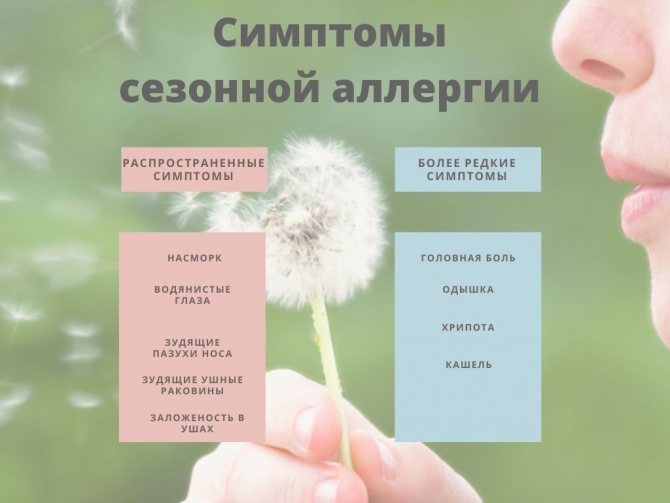
Table of main symptoms of seasonal allergies
Seasonal allergy symptoms range from mild to severe. The most common are:
- sneezing;
- runny nose;
- watery and itchy eyes;
- itching of the sinuses, throat, or ear canals;
- ear congestion;
- postnasal drip.
Less common symptoms include:
- headache;
- shortness of breath;
- hoarseness;
- cough.
Many people who have allergic rhinitis also have asthma (which leads to shortness of breath), possibly caused by the same allergens that contribute to allergic rhinitis and conjunctivitis.
Diagnosis of seasonal allergies
Seasonal fever is usually easier to diagnose than other types of allergies. Quite simply, if you only experience allergic symptoms at certain times of the year, then this is a sign that you have seasonal allergic rhinitis. To diagnose seasonal allergies, your doctor must check your ears, nose, and throat.
To determine mild allergies, testing is usually not required. Your treatment for allergic rhinitis will likely be the same no matter what type of allergen you are reacting to. Seasonal allergies are fairly easy to identify because the pattern of symptoms repeats from year to year after exposure to the allergen. Diagnosis of allergies is carried out by allergists and clinical immunologists. First, a physical examination is carried out; if a specialist cannot make a diagnosis, the allergy is determined by skin testing. If the body reacts to an allergen, the skin in that area will become slightly swollen or red.
Another method for determining the allergen is as follows. A small amount of the allergen is injected under the skin. After about 15 minutes, if a lump appears at the injection site surrounded by a reddish area (looking like a mosquito bite), the test is considered positive.
Even if a skin test shows an allergy, the person or child must have seasonal allergy symptoms to be sure.
How to treat seasonal allergies
The best cure for hay fever and year-round allergic rhinitis is to avoid the allergens that cause your symptoms. Allergy symptoms can also be relieved with medications; some people also try alternative treatments.
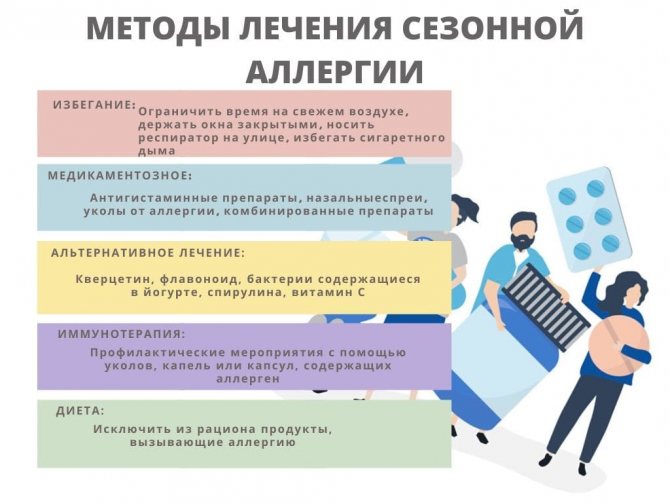
Recommendations for treating seasonal allergies
How to get rid of seasonal allergies
Evasion
The method is quite simple, a person simply tries to avoid seasonal allergens. For example, using an air conditioner with a HEPA filter to cool your home in the summer instead of a fan. Constant monitoring of the local weather network, which reports the presence of pollen, can also help to avoid encounters with allergens. Try to spend more time indoors when pollen counts are high. During the active allergy period, try to:
- keep your windows closed;
- limit time outdoors;
- Wear a respirator when you are outside, especially on windy days;
- Avoid cigarette smoke, which can worsen seasonal allergy symptoms.
Drug treatment
If you cannot avoid allergens, use medication:
- over-the-counter antihistamines such as cetirizine;
- combination medications containing acetaminophen, diphenhydramine, and phenylephrine;
- steroid nasal sprays;
- allergy injections. In severe cases, your doctor may recommend allergy shots. This type of immunotherapy can help desensitize your immune system to allergens.
Before deciding what to drink for seasonal allergies, consult your doctor. Some allergy medications may have unwanted side effects such as drowsiness, dizziness, and confusion.
Alternative Treatments
Several studies have been conducted on alternative treatments for seasonal allergies. Some people find that the following alternative treatments may help:
- Quercetin is a flavonoid that gives color to fruits and vegetables;
- Lactobacillus acidophilus is a “friendly” bacteria found in yogurt;
- Spirulina is a type of blue-green algae;
- Vitamin C, which has some antihistamine properties.
However, more research is needed to see if these alternative treatments are effective.
Immunotherapy
This therapy includes preventive measures using injections, drops or capsules containing the allergen. This is done before the start of the allergen season so that the body forms protective factors and does not show an allergic reaction to a certain allergen. This method of combating seasonal allergies shows good results. It is believed that three years of such therapy helps a person forget about allergies for 12 years (at least from the aggressive influence of allergies on the body).
Diet
This method helps to forget about seasonal allergies if a person follows a diet and follows the recommendations of doctors. In the next article we will share tips on how to cure seasonal allergies and with what medications.
Treatment at home and at resorts
Allergen-specific immunotherapy
This technique allows you to achieve good results in the treatment of allergies. The basis of the method is the introduction into the body of special vaccines made on the basis of allergens (for example, plant pollen). They start with a minimum dose, gradually bringing the result to the development of complete immunity to the irritant.
Taking antihistamines (in the form of tablets, nasal sprays and eye drops).
- Examples of eye drops: Livostin, Emadin, Telfast.
- Allergy pills in the summer - Claritin, Tavegil, Diphenhydramine, Suprastin.
Products such as Suprastin and Tavegil are suitable even for infants (check with your pediatrician first!).
A special case is the possibility of taking antihistamines for allergies in the summer for pregnant and lactating women.
First generation antihistamines are strictly prohibited due to their negative effects on the fetus (Diphenhydramine, Tavegil, Diazolin, Suprastin). Second generation antihistamines can be taken only for health reasons (Claritin, Cetirizine). Third generation drugs can be used during pregnancy after consultation with a doctor (Levocyterizine, Fexofenadine).
The following articles will help you understand your situation:
- Allergies in pregnant women
- Allergies in nursing mothers
Ointments containing panthenol, lanolin, retinol.
Ointments such as Pantoderm, Bepanten (with Panthenol) have a wound-healing effect, Lanolin ointment is an emollient and analgesic, Videstim and Radevit (with Retinol) have a regenerating effect.
Hormonal ointments are used carefully, only as prescribed by a doctor. Examples: hydrocortisone ointment, Elokom, Advantan, Flucinar.
Spa treatment of allergies
Sanatorium Divnomorskoye - dormitory building No. 1
When choosing a resort, you must take into account that the main thing for an allergy sufferer is a hypoallergenic environment. Areas with a moderate, mild climate, without a large temperature difference, preferably on the seashore or in the mountains, are ideal. The resorts of Crimea and the Black Sea coast of Russia (Divnomorskoe, Anapa, Gelendzhik) are well suited for treatment.
The optimal time for rest is September-October, when the grasses finish flowering. A good option is Kislovodsk or Nalchik. From the northern resorts - the coast of the Gulf of Finland.
The tropical countries of Africa and Southeast Asia are absolutely not suitable for allergy sufferers, since there is a high probability of allergies from unfamiliar fruits or tropical insect bites. And a sharp change in climate will not have the best effect on your well-being.
Is it possible for a child with allergies to relax in Divnomorsk in the summer?
One of the areas of treatment at the resorts of Divnomorsk is allergies of all types. And the Pitsunda pine, for which this village is famous, blooms in March and April. If you are allergic to herbs, it is better to go on vacation to Divnomorsk in September-October.
What should a person with allergies do before going on a trip?
- Take with you a set of antiallergic medications, including for emergency use.
- Learn the necessary phrases regarding allergies in the language of the country you are traveling to. A special bracelet or allergy card can help in this regard.
- Find out in advance whether it is possible to book a hypoallergenic hotel (this is possible in Western Europe and the USA).
Prevention of hay fever or how to prevent seasonal allergies
In order to reduce unwanted allergy symptoms, it is necessary to carry out systematic therapy. See your doctor who can prescribe appropriate antihistamines, nose and eye drops, and throat sprays for you. This conventional therapy will help get rid of acute forms of allergies and solve the problem of severe intolerance to certain allergens.
These precautions are for mild to moderate allergies. It’s another matter when a person or child reacts to everything around them. In this case, nasal congestion, sneezing, conjunctivitis, asthma, Quincke's edema, and even urticaria are observed. With this condition, drug treatment cannot be avoided. The doctor prescribes hormonal medications, immunotherapy, home or hospital regimens. Indoor allergens (at home) are easier to remove from the environment than outdoor pollen, but it is doable. Below we share with you tips from experts on how to deal with seasonal allergies.
- Wash bedding in very hot water at least once a week.
- Cover your bedding and pillows with anti-allergen covers.
- Get rid of carpets and old upholstered furniture.
- Remove stuffed animals from your children's bedrooms.
- Repair water leaks and water damage on walls and furniture that can help mold and pests spread.
- Clean moldy surfaces and any areas that can form mold, including humidifiers, swamp coolers, air conditioners and refrigerators.
- Use a dehumidifier to reduce excess moisture.
In order to reduce the level of allergies to external irritants, preventing the development of allergic hay fever is quite simple:
- change your geographical location (to a different climatic area) during the flowering period (if possible);
- try to go outside when absolutely necessary, avoid country walks in windy weather;
- take walks after rain or in cloudy weather when the flowers are closed;
- arrange wet cleaning of the apartment, moisturize window screens;
- exclude therapy with herbal components (herbal medicine), exclude honey and other bee products if you are allergic to tree pollen;
- exclude from your diet raw carrots, grains (cereals and bran porridges), unrefined oil, mayonnaise, chicory, halva and melons.
No Allergies!
Contents [Show]
Seasonal allergies (mainly spring, summer, autumn allergies or hay fever) are an excessive reaction of the human immune system to allergens (various biologically active substances) that a person comes into contact with at a particular time of the year. Symptoms of seasonal allergies can be observed in anyone, regardless of the climatic conditions in which they live, gender or age.
Hay fever is caused by the body's sensitivity to pollen and flowers. It is customary to distinguish seasonal waves of allergies, which correspond to periods of plant growth and weather conditions. In May, allergens include the flowering of birch, alder and oak. At the beginning of summer comes the period of allergies to poplar, pine, spruce, dandelions, and fescue. In mid-summer it is linden and meadow grasses (timothy, wheatgrass, etc.). And in August - quinoa, wormwood, ambrosia. September is characterized by allergies to hay, dry leaves and grass.

The main causes of seasonal allergies are exposure to pollen and substances contained in fruits, berries, vegetables, etc. on the human body. During flowering or when using these products in our menu, the likelihood of seasonal allergies becoming worse increases.
In addition, after the snow melts, a large amount of mold fungi and chemicals accumulated in the snow from car emissions and reagents that contribute to the appearance of allergy symptoms even before flowering begins: the appearance of red spots on the skin, cutting pain in the eyes, runny nose. , discomfort in the throat, sore throat, cough, hives. In addition to allergy sufferers, people with chronic diseases of the skin and ENT organs are at increased risk. The following reasons contribute to a predisposition to allergies:
- Hereditary factor (if one or two parents had an allergy, then there is a 70% chance that the child will also develop it);
- Unfavorable environmental situation (industrial emissions and vehicle emissions);
- A person's tendency to develop other types of allergies. In this case, seasonal allergy disease is a secondary disease;
- The body is highly sensitive to certain allergens. The immune system begins to produce antibodies in response to allergens, such as pollen;
- Chronic diseases of the bronchi and lungs;
- Weakened immune system;
- Harmful work (for example, contact with harmful substances through the skin, mucous membranes of the eyes, breathing).
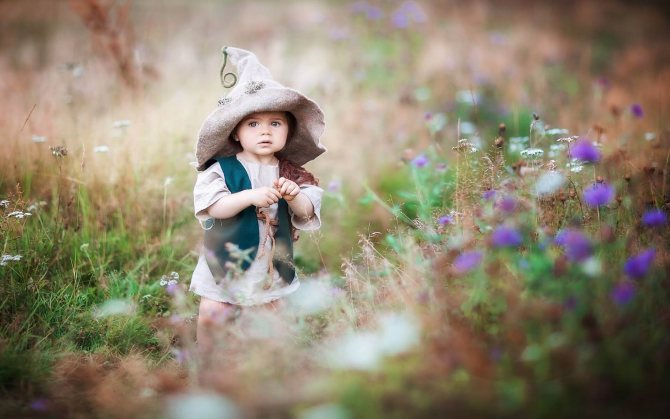
Seasonal allergies (or hay fever) can have various manifestations: runny nose, sneezing, skin inflammation (rashes, pimples, peeling, redness) or even asthma attacks. But most often, the symptoms of hay fever are expressed in the form of a runny nose in combination with redness of the eyes (up to conjunctivitis).
Often a person confuses allergy symptoms with signs of a cold and may begin to self-medicate incorrectly. A number of differences between allergies and ARVI:
- Rarely is there an increase in temperature;
- sneezing becomes frequent;
- nasal discharge is liquid and has a characteristic transparency;
- headache as a result of intoxication from the effects of pollen on the body;
- general weakness of the body;
- insomnia;
- itching appears in the nose, throat and ears;
- nasal discharge and itching worsen in dry, windy weather, and weaken during rain;
- Allergies usually last longer than a cold (the symptoms of a cold, as a rule, do not last longer than one week).
In babies and preschool children, seasonal allergies often begin with clear snot, sneezing and rashes similar to diathesis (dry patches on the skin, redness, small rash with pimples, peeling of the skin), then the eyes become red, swollen and watery. At the initial stages of the disease, allergies in children can be confused with seasonal diseases.
Depending on the intensity of the allergy, there may be purulent discharge from the eyes (conjunctivitis) and asthma attacks. Sometimes asthma goes away as you get older. Some children experience severe ear congestion. A preschooler will complain to his mother about pain in his ears. And a younger baby will simply cry and experience pain when pressing on the ears. It is impossible to take the street out of the life of an adult, much less a child, from where allergens come en masse. The main danger of seasonal allergies is that they can combine with allergic reactions to dust or pets and lead to dermatitis or asthma.
Allergies should be treated not only at the time of exacerbation, but also prevention should be carried out on the eve of allergy season. Allergies can be effectively dealt with only through complex treatment; experienced allergy sufferers have already been convinced of this for years.
Comprehensive treatment of seasonal allergies includes a combination of antihistamines with high-quality sorbents, eye drops and nasal spray, and skin cream are used topically. Antihistamines are a good fighter against an allergic reaction that has already occurred, but it should be remembered that they alleviate the external symptoms of the disease and do not eliminate the causes of its occurrence inside the body. Thus, the body continues to experience the effects of allergens, despite the relief of external symptoms. Sorbents can get rid of the cause of allergies and stop the development of an allergic reaction. A distinctive feature of sorbents is its true purpose for removing everything harmful.
One of the most effective sorbents is Polysorb, which has proven itself for 20 years; every third family in Russia uses it.
Advantages of Polysorb in the treatment of allergies in children:
- The drug quickly eliminates the very cause of the allergy;
- Captures and removes allergens from the body without harm to the gastrointestinal tract;
- The drug is in powder form (more quickly absorbed than tablets and gels) and is easy to use (diluted with water, compote, juice, can be given to children from a bottle);
- Polysorb removes only the harmful, leaving the useful;
- The drug can be used not only by adults, but also by children of any age, as well as pregnant and nursing mothers;
- Polysorb is recommended to be used not only for the treatment of seasonal allergies, but also for its prevention.
If you experience heavy breathing or a feeling of suffocation, you should consult a doctor to rule out angioedema, which requires urgent qualified medical care. Hives also require examination by a doctor.
Allergy symptoms are especially dangerous for children, pregnant women and the elderly, for whose health it is especially important to diagnose the disease in time and avoid complications.
In the home of allergy sufferers, during an exacerbation or allergy season, it is worth carrying out daily wet cleaning and having a humidifier.
Children with a predisposition to allergies (whose both or one of the parents have a tendency to allergic diseases) should be fed with breast milk longer, and complementary foods should be introduced with special attention.
It is worth following a hypoallergenic diet, which means avoiding foods that cause an allergic reaction, so as not to aggravate the condition.
Pregnant women should be careful when taking medications, as the list of drugs is quite limited. Treatment is prescribed by a doctor. Polysorb sorbent can be used during pregnancy and childhood from the first days of life.
When writing this article, information from this site was used.
How to treat seasonal allergies in children
Seasonal allergies in children
Every year more and more children suffer from seasonal allergies. This is due to a reduced immune system. Allergic reactions are the body’s response to external irritants that are in the air during a certain season, or more precisely, from spring to autumn. Allergens include plant pollen, various grasses, shrubs, and mold spores that live not only in damp rooms, but also in the open environment.
With constant observations, experts concluded that most often seasonal allergies occur in children aged from one to 2-3 years.
Attention! Mostly, allergic reactions occur in children who have a genetic predisposition to the disease, especially if their parents suffer from allergies.
During a period when immunity decreases (for example, due to an illness), a substance, for example, pollen, which is perceived by the immune system as a foreign dangerous element, can enter the child’s body, and in response, a protective reaction begins - the production of antibodies.
Initially, this reaction occurs unnoticed by the child, that is, without any symptoms. But after a certain period passes, the reaction to the same allergens becomes more aggressive, and the body begins to secrete histamines and other specific substances, an excessive amount of which manifests itself in unpleasant symptoms that cause discomfort to the baby.
In some cases, allergic reactions may resemble bronchial asthma and manifest themselves in the form of shortness of breath, coughing, suffocation
As a result of seasonal allergies, children begin to experience unpleasant symptoms:
- sneezing that continues until contact with the provoking substance is eliminated;
- in the nasal passages, on the palate, in the throat, the baby feels a feeling of severe itching, which interferes with full breathing through the nose;
- nasal congestion and discharge in the form of clear liquid appear; the runny nose disappears while the child is indoors;
- there is a burning sensation in the eyes, lacrimation appears, and conjunctivitis may develop in weak children;
- in some cases, allergic reactions may resemble bronchial asthma and manifest themselves in the form of shortness of breath, coughing, whistling appears during breathing, and suffocation may begin;
- possible rashes on the skin;
- Quite rarely, a complication of allergies in the form of Quincke's edema is possible; in this case, you should immediately call an ambulance.
In young children, parents often confuse the symptoms of seasonal allergies with colds. This also occurs due to the addition of a feeling of lethargy, headache, increased irritability (tearfulness in the smallest children), decreased hearing and sense of smell, and increased body temperature of the child. But with allergies, enlarged lymph nodes are not observed.
You should be very careful about the baby’s health, especially if family members have allergies, because such a baby is at risk.
The presence of worm eggs in the body can affect the development of allergies
Factors influencing the development of allergies are:
- disruptions in liver function;
- the presence of worm eggs in the body;
- intestinal dysbiosis;
- excessive consumption of foods that can cause allergic reactions, such as milk, chocolate, pastries, pies, sweets and others; as a result of constant consumption of such products, the intestinal mucosa is gradually damaged and increased sensitivity occurs;
- colds, especially during summer and autumn;
- if the apartment is not frequently wet cleaned and there are numerous carpets and furniture;
- if pets live in the apartment;
- the presence of mold in the room where the baby lives.
If several predisposing factors are present, this will certainly become a trigger when encountering an allergen.
Products that can cause allergies: milk, chocolate, pastries, pies, sweets
When children begin to show symptoms of seasonal allergies, first of all it is necessary to take the child for a consultation with a treating specialist, who, after examination and examination, will be able to confirm or refute the presence of ARVI.
Advice: If the problem is not related to colds, you should immediately go with your baby to an appointment with an allergist.
Initially, the specialist will examine the child and conduct a survey of the parents, which will include finding out information about the child’s development, past illnesses, and the presence of chronic pathologies. After this, the doctor will issue a referral for the necessary tests: blood, urine, fluid released from the nasal passages, and others.
After the results of the examination, special tests are carried out, as well as a blood test to determine the type of plant that provoked seasonal allergies in children.
A skin test (scarification tests) is a procedure during which small incisions are made on the skin (scratches) and an allergen substance is injected there. This test is carried out during the period when plants finish flowering, that is, from late autumn to the end of March. The duration of the procedure itself is no more than half an hour, but this is quite problematic for children under 5 years old, because they should sit still. Therefore, skin testing is not prescribed to very young children.
An allergist doing skin tests on a child
The youngest children undergo a blood test for antibodies to the irritant. This diagnostic measure does not depend on the time of year or flowering season.
Very often, food intolerance is closely related to allergic reactions to plant pollen.
Important! If seasonal allergies are detected in children, it is necessary not only to begin treatment measures during the flowering period, but also long before its onset for preventive purposes.
To effectively help your child, it is better to find an experienced allergist who will prescribe competent treatment and can give recommendations on how to prevent the disease.
Treatment of allergic manifestations in children consists of prescribing medications with antihistamine action, sorbents, anti-inflammatory eye drops, nasal sprays, as well as ointments for skin rashes.
Important! During the period of exacerbation, it is necessary to exclude contact with allergens as much as possible; the child should be indoors more often.
It is also very important to follow a dietary diet, from which it is better to exclude bee products, citrus fruits, bananas, strawberries and other highly allergenic foods. In addition, you should limit the amount of sweets, fatty, fried foods and smoked foods you consume. To help the child's body cleanse itself of harmful substances, your child should drink a sufficient amount of purified (boiled) water without gas.
Products that often cause food allergies: milk, eggs, strawberries, citrus fruits and others
To improve the child’s condition not only during the onset of seasonal allergies, you need to carry out wet cleaning in the apartment every day (wipe dust from furniture, wash the floor), you should also get rid of carpets and soft toys if there are too many of them in the house. A good way to use a humidifier is to maintain the required humidity. This will make it easier for the child to breathe.
In addition, dietary food should always be present in the baby’s diet, which means it is better to exclude allergic foods.
Such a common topic as seasonal allergies in children worries many parents, so for more complete information we recommend watching a video with Dr. Komarovsky, who will tell you quite accurately about the solution to this problem.
When you hear that your baby is sneezing and sniffling a lot, the first thought is a cold. It is no secret that seasonal allergies in children begin in a similar way; for this reason, treatment of hay fever is delayed, which subsequently aggravates the course of the disease. The hay fever season begins during the flowering period of grasses, trees and shrubs, and ends only in late autumn. According to allergists, seasonal allergies began to appear more often in children 1.5-2 years old.
Children in a family with allergies are more prone to hay fever. After the first entry of small amounts of pollen into the body through the respiratory system or eyes, the allergen is recognized. The immune system begins to produce antibodies against the foreign agent pollen. Externally, this period of sensitization may occur asymptomatically. However, next year, when inhaling the same type of pollen, immune cells for some reason begin to produce specific substances - histamines, cytokines, etc. Their excess causes allergic inflammation of the mucous membranes of the eyes and respiratory tract.
Symptoms of hay fever include:
- Frequent sneezing (3-10 times in a row).
- Itching in the nose and nasopharynx. The baby tries to breathe through his mouth, wrinkles his nose and rubs it with his hand.
- Fluid discharge from the nose, reminiscent of a runny nose. Periodic nasal congestion - allergic rhinitis. The condition improves if you do not go outside for a while.
- Pain in the eyes and lacrimation, in some cases conjunctivitis develops.
- Sometimes hay fever develops into allergic bronchial asthma, accompanied by shortness of breath, wheezing, suffocation, wheezing and dry cough.
- Some patients experience skin manifestations - intense itching, red rash, contact or atopic dermatitis. In rare cases, Quincke's edema occurs. Without timely medical care, a person may die from suffocation.
Symptoms of seasonal allergies in children are much like the common cold. Along with this, headaches, congestion in the ears, decreased hearing and sense of smell, apathy and irritability may occur. Occasionally a low temperature rises. Unlike a cold, the submandibular and postauricular lymph nodes are not enlarged. Against the background of a pollen allergy, a child may develop a cold, which will increase the recovery period and reduce the effect of antihistamines.
A child automatically falls into the risk group for allergies if there are people in the family with signs of this disease.
The development of allergies can be triggered by:
- Liver disorders.
- Helminthic infestations.
- Dysbacteriosis in the intestines.
- Eating large amounts of sweets, dairy and flour products. Abuse of these products provokes damage to the mucous membrane. As a result, she becomes overly sensitive to allergens.
- An acute respiratory infection that began in spring and summer during the flowering season.
- Home environment: the apartment has a lot of carpets, books and other surfaces where dust collects; Pets; low or high humidity; mold and fungi on the walls; the presence of insects - bedbugs, cockroaches, etc.
A simultaneous combination of several factors - hereditary predisposition, a cold - and receiving a significant dose of pollen while walking can trigger hay fever.
If it seems to you that the child has developed an allergic disease, then first you need to examine the baby for ARVI, bronchitis, etc. After the pediatrician and ENT doctor confirm the absence of pathologies, you need to consult with an allergist-immunologist.
The doctor will ask the parents in detail about the child’s development, past infectious and other diseases, the presence of chronic diseases, etc. The child will undergo several tests of blood, urine, nasal mucus, etc.
Next, we will begin to identify substances and plants that cause allergies. This is done in two ways:
- Using skin tests - prick tests. A series of specially prepared solutions containing certain allergens are dripped onto the scratched area of skin. According to the rules, the analysis is done during the season free from flowering (from October to March), and at least 10-12 days after stopping taking antihistamines. The procedure takes about 20-30 minutes. The child will have to sit still, which is difficult for children under 5 years old. For this reason, the study is not suitable for small children.
- A blood test for antibodies to pollen - class E immunoglobulins. This blood test is the only option for determining allergies in children. The analysis can be done year-round, regardless of medications taken or the presence of other diseases.
A child may have hay fever and an allergy to any food product at the same time. For example, ragweed pollen and banana. Even during the non-flowering period, eating bananas provokes seasonal allergy symptoms.
It has been revealed that allergies to pollen of some plants are directly related to an allergic reaction to food. If a person is allergic to hazel, birch, alder or apple blossoms, then there is a good chance that he will react to potatoes, birch sap, apples, cherries, peaches, plums, hazelnuts, tomatoes, avocados, carrots and celery.
https://proallergiju.ru/www.youtube.com/watch?v=5j0Tv_2X06E
Over the years, allergies can manifest themselves in different ways:
- Symptoms of hay fever appear at the same time every year.
- Year after year, the symptoms of seasonal allergies worsen and bring more and more discomfort.
- Hay fever turns into bronchial asthma.
In order not to start the disease and not worsen the child’s condition, hay fever must be treated in a timely manner.
Conventionally, treatment is divided into 3 phases:
- Before the arrival of the flowering season, they begin to take medications to prevent an allergic attack.
- During the flowering season, antihistamines are prescribed (Zodak, Zyrtec, Fenistil).
- During the calm period, diagnostics and treatment are carried out with minute doses of allergens. This approach accustoms the body to the effects of allergens, which reduces the manifestations of hay fever in the next season.
A few weeks before the onset of flowering, preventive administration of cromoglycates (Cromohexal, etc.) is started in the form of nasal and eye drops, as well as an aerosol into the bronchi.
These drugs block the allergic reaction. They are used throughout the flowering period, that is, every day for several months. Please note that taking cromoglycates does not help when they are used during the flowering period.
For exacerbations, take antihistamines and hormonal drops or sprays for the nose and eyes. In the case of bronchial asthma, bronchodilators and local hormonal medications are used. Antihistamines act only on the histamines responsible for the allergic reaction. Because of them, itching in the nose, sneezing and watery discharge begins. When a patient is concerned about congestion and swelling of the nasal mucosa, the doctor prescribes vasoconstrictor drops to facilitate nasal breathing. Sometimes they may prescribe nasal drops that additionally contain antihistamines or hormonal components (Vibrocil, Sanorin-Analergin, etc.). Remember that they cannot be used for more than 5-7 days in a row.
If this therapy does not help, topical aerosol glucocorticoids are prescribed into the nose or bronchi, as well as ointment or eye cream. They effectively relieve inflammation and prevent the production of substances that cause symptoms of hay fever. This medicine does not enter the bloodstream and has no noticeable effect on the entire body. A short course is enough to improve the condition. In addition to glucocorticoids, antiallergic drugs are recommended, especially when the patient suffers from rhinitis with nasal congestion.
https://proallergiju.ru/www.youtube.com/watch?v=mxs5ImLkrAQ
Seasonal allergies in young children can be triggered by heredity, complications from viral diseases and contact with flowering plants. However, it will not be possible to protect a child from all flowers and plants, so at the first signs of an allergy, you need to thoroughly examine your child and begin treatment. In addition to constant congestion, sneezing, watery eyes and runny nose, hay fever can provoke bronchial asthma, which will seriously complicate the life and well-being of the baby in the future.
Rate this article:
Seasonal allergies in children in the spring are not so rare, and therefore represent a serious danger that must be dealt with using proven methods.
Seasonal allergies also have another name, hay fever, and are an allergic reaction to tree blossoms and pollen production, and most often occur in the spring. Moreover, not only trees can bloom, but also flowers and herbs, which can also cause signs of such an allergy. Typically, the season for this type of disease is from May to August, but often this period can begin earlier and end later due to unfavorable changes in the climate around us. In addition to plants, allergies can be caused by the development of fungi from the mold family, which can also be found either in the air or, worse, on the surface of objects around us. Very often they are found in bathrooms or rooms with high humidity.
Children very often suffer from such allergies by breathing pollen scattered in the air. Symptoms worsen in dry, windy weather, but after rain the pollen becomes attached and the condition may improve significantly. An allergy is the body’s way of responding to a foreign substance, or more precisely, a substance that the body considers foreign due to improper functioning of the immune system.
Signs of an allergic reaction.
Seasonal allergies in children have the following symptoms:
- Nasal congestion, which leads to rhinitis. It is accompanied by itching in the nasal cavity, sneezing, and runny nose. All this quite quickly translates into swelling of the mucous membranes and decreased sensitivity to odors.
- Eye irritation - conjunctivitis, itching, red white color and constant tears for no reason.
- Breathing problems – shortness of breath or even suffocation may occur if asthma develops, the child has a dry cough and has difficulty breathing.
- Dermatitis appears on the skin, which is very itchy. Dermatitis can develop into hives and even a rash.
- The child looks tired and complains of pain in the head. And if this is a baby under one year old, he cries a lot.
- A sign of an allergy is not an increase in temperature. This is its main difference from viral and respiratory diseases.
Why do allergies occur in children?
The causes of allergies may be the following:
- The allergy is inherited;
- During pregnancy, the mother suffered from a disease caused by viruses or infection;
- The child often catches colds and has reduced immunity;
- Unfavorable environmental conditions;
- Lack of breastfeeding and subsequent poor nutrition, leading to disruptions in the digestive system;
- Problems with vaccination.
How to deal with allergies in children
Basic anti-allergy medications.
If any of the signs of seasonal allergies are detected, it is important to immediately consult a doctor, who will determine whether it is really a seasonal allergy or whether it is caused by other unfavorable situations. So, in addition to seasonal allergies, unpleasant factors can be caused by dust, wool, food or allergens.
You can fight allergies with all the usual antihistamines, which should be suitable for children. The doctor will prescribe treatment for you, but you still also remember what you need to keep in your first aid kit in case your child has allergic reactions.
How can I help my child relieve seasonal allergies? Antihistamines, as well as agents to increase the sensitivity of the cell membrane, can cope with this.
Medicines of this type, approved for children aged 1 to 2 years, include tablets:
- Lomilan,
- Clarisens,
- Loratodine,
- Clarotadine,
- Claritin.
Medicines for children over 2 years old include syrups and drops:
- Fenistil in drops,
- Zodak,
- Tsetrin,
- Zyrtec,
- Parlazin,
- Ketotifen only in syrup.
Nasal remedies to relieve a runny nose:
- Cromoghlin,
- Cromohexal,
- After 2 years Intal.
Eye drops:
- From 2 years Alomid,
- From 4 years old Highkrom,
- From the age of 12, Allergodil, Lecrolin, Opatanol, Histimet.
Allergy creams:
- Fenistil,
- Gistan,
- Skin Cap,
- Eliden,
- Desitin,
- Protopik,
- Wundehil.
It is highly discouraged to use corticosteroids in children, as they are intended to treat only dangerous cases and under the close supervision of a physician. Of course, they immediately eliminate the symptoms, but their consequences can be very dangerous for children.
Interesting facts about allergies
Treating a child for seasonal allergies takes a long time also because the allergy can manifest itself not only to flowering trees and plants, but also to herbs adjacent to them, as well as food products. From April to May you can see birches, oaks and alders bloom, in June poplars, pine and spruce, as well as the hated dandelions, in the middle of summer linden and wheatgrass bloom, and in August wormwood and quinoa.
Hay fever can be predicted. If your child, unfortunately, already has an allergy, then with a high degree of probability a seasonal one may also appear. So, an allergy to carrots will complicate the flowering of alder, and an allergy to melon will complicate the flowering of dandelions. Plum has related proteins with birch, kiwi and potatoes with apple trees, honey and halva with dandelions and wormwood, and citrus fruits are also marred by an allergy to chamomile.
To facilitate therapeutic therapy, it is necessary to instill in the child an appropriate, correct daily routine. It is necessary to put the child to bed on time and soothe the skin with water. It is also important to establish proper nutrition and maintain a hydration regimen.
Wet cleaning of the house will help cope with the signs of allergies. Wipe all accessible objects - it is better to put books, toys, carpets away, or you can get rid of them altogether. Remove unnecessary indoor plants, and if you are allergic to wool, you will have to part with your pets.
Treatment of seasonal allergies in children can also be carried out using folk remedies, but often such recipes contain herbal decoctions, which can also be sources of its occurrence. But if you know all the child’s allergens, you can try to treat him in the following ways:
- Infusion of black currant branches;
- Horsetail decoction;
- Nettle decoction;
- Juice from the root part of celery;
- Oil extracts of fennel and dill in the absence of allergies to essential oils;
- Saline solution;
- Taking figs fresh or dried;
- Taking mumiyo - suitable for children from 3 years old;
- Baths made of clay or a decoction of string.
By following all the rules and performing the above actions, you will be able to make it easier for your child to experience seasonal allergies and successfully cope with them. Remember the importance of seeing an allergist or pediatrician to prescribe medications. Do not prescribe medications yourself under any circumstances - this is dangerous. Be healthy!
Rate this article
(
votes, rating:
out of 5)
If you find an error in the text, be sure to let us know about it. To do this, simply highlight the text with the error and press Shift + Enter or simply click here . Thank you very much!
Thank you for notifying us about the error. We will fix everything soon and the site will become even better!
What is important to know about cross allergies?
Cross allergy is characterized by the effect on the body of respiratory and food allergens. Cross allergy occurs due to the fact that allergens from different sources have a similar structure or even relatedness. In such cases, it is important to follow a hypoallergenic diet. By eliminating major allergens from the diet, the diet helps reduce the burden on the body and quickly return to normal. When following a hypoallergenic diet, it is important to steam, boil or bake foods. When following a hypoallergenic diet, the following should be excluded from the diet:
- honey and bee products;
- alcohol;
- Birch juice;
- nuts (hazelnuts, walnuts, almonds) and products containing nuts;
- stone fruits (cherries, sweet cherries, olives, peaches, plums, apricots);
- apples, pears, kiwi;
- carrot.
Individual intolerance to certain foods may occur, for example: potatoes, tomatoes, cucumbers and onions. In such cases, the doctor also excludes these foods. The symptoms of respiratory and cross allergies are similar, so it is important to see a doctor and conduct allergy tests in order to make a correct diagnosis and choose the right treatment tactics.
Who may experience cross-reactions?
People who suffer from the strongest allergens are also susceptible to cross-reactions. Allergies can only occur during certain periods, for example during flowering. For some people, allergies can occur throughout the year. With cross allergies, people usually experience discomfort in the mouth and throat, especially when they eat raw fruits or vegetables. An allergy that manifests itself in the oral cavity is called “oral allergy syndrome.” The intensity of symptoms may vary and spread to other organs (for example, itching in the ears may occur). At worst, allergies can lead to anaphylactic shock, but this is extremely rare.
Home help
Parents can prevent the occurrence of unpleasant diseases associated with allergies in a child or significantly reduce them. To do this you need:
- Close windows during the day. This may be tiring, but for a sick child such a “closed house” becomes a refuge. The best time to ventilate an allergy sufferer's apartment - with the exception of his bedroom - is between 10 pm and 6 am.
- Avoid walking with your baby when the air is very dry. If you need to leave the house, you need to take mineral water, wet wipes and an inhaler with you in case of an attack. If we are talking about walking time, then the evening hours will be much safer for the child.
- Refuse to bring wildflowers into your home. Your baby needs to take a short shower, especially after walks and before bed. If possible, the temperature in the apartment should be maintained at 20 degrees.
Remember that taking preventive measures, as well as regular consultations with a doctor, will lead to a reduction in allergies.
Alergino 766
Key Thoughts on Seasonal Allergies
Can seasonal allergies be cured? No one can give you an exact answer to this question, since it is all too individual. Get timely diagnosis and adequate treatment of seasonal allergies using modern medications. This will allow you to quickly eliminate the symptoms of seasonal hay fever.
The most common method of treating seasonal allergies is antihistamines, we will talk about them in more detail in the next article.
We also strongly recommend not to self-medicate; only a doctor can prescribe what to take for seasonal allergies, so as not to cause your body to have acute reactions. Avoid allergens, take preventive measures, but if the first symptoms of an allergy occur (if this is your first time), consult a doctor, he will help identify allergens, make a diagnosis and eliminate the disease. Remember, your health is in your hands. In the following articles, we will also look at whether it is possible to breastfeed with seasonal allergies and how to treat if the allergy occurs during pregnancy.
Share with friends
Rate this article

